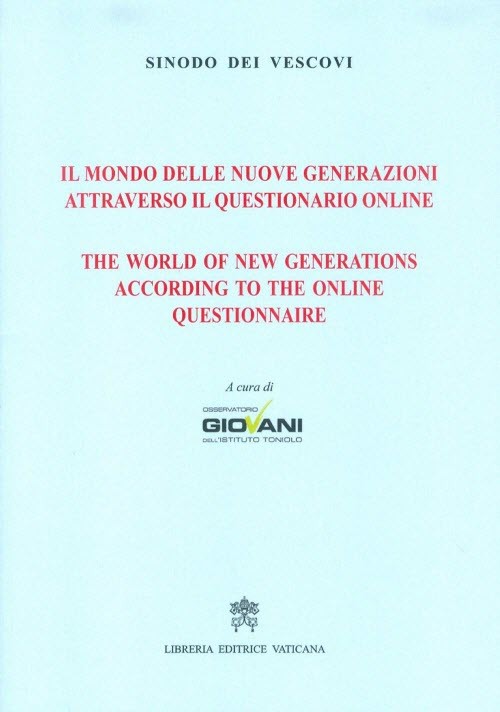Book: The World of New Generations According to the Online Questionnaire

The General Secretariat of the Synod of Bishops makes available the publication: The World of New Generations According to the Online Questionnaire
The path of preparation of the Synod of Bishops dedicated to youth has become an opportunity for the realization of one of the broadest and most interesting listening experiences of the new generations of all time in the whole world.
The instruments suitable to this end were many and diverse. However, the will to speak to youths directly was something specifically new. Among the various initiatives in this direction was a questionnaire ‒ accessible online (in various languages) from mid-June to December 2017 ‒ that allowed us to reach many young people from around the world. Overall, more than 200,000 made contact (with more than half who filled it out completely).
Nevertheless, active listening requires direct encounter and discussion. A response in this direction came through the International Seminar on young people that took place in Rome in September 2017, which was envisioned as an occasion of cognitive sharing and discussion among various disciplines and young people from every continent. The most advanced point of active and participatory listening was the pre-synodal meeting which saw the participation of 300 youths from around the world (and 15,000 through social media). For one week, these participants exchanged views by elaborating their reflections which were merged into a document that expresses (with doubts, uncertainties, desires and hopes) the thoughts and experiences of young people in the 21st century.
The online questionnaire wasn’t the only instrument of involvement and listening for the new generation; it did however allow the most extensive method of gathering young people wherever they are in the world.
Despite its length, some important themes (such as affections and sexuality) were not discussed, especially because they could not be explored with a survey of this kind (in any case, the open questions allowed for other elements to be added). Moreover, one of the most virtuous aspects of listening for the Synod was putting in place various instruments suitable to various objectives. The themes of affections and sexuality, for example, were discussed in the pre-synodal meeting and is reflected upon in the document produced on that occasion.
The aim of the online survey was twofold.
First, and foremost, it virtually gave every person between the ages of 16-29, wherever they were in the world, the opportunity to speak and make their own contribution to the path of the Synod. The questionnaire not only presents “closed” questions, but also two “open” questions with the possibility of freely expressing opinions and states of mind, while allowing for requests and proposals. All this material has been used as a source for the Instrumentum Laboris.
The second aim is to use the great participation of the online questionnaire as a source of valuable information to paint a portrait of the reality of young people, their expectations and their life plans, the values and desires that guide their choices and the context in which they find themselves (being able to compare realities and conditions in various parts of the world). The analysis of this data is limited by not being strictly representative in a statistical sense since participation was voluntary (therefore affected by self-selection mechanisms) but it has the merit of having a high number of survey participants from around the world. The high number is even more relevant if one thinks of the commitment required to fill it out due to the length of the questionnaire (one must also consider that many responded via smartphone). Moreover, it is the first generation that has the possibility of being reached out to simultaneously in such an extended way in every corner of the globe. It is also interesting to note that, despite the age range (from 16 to 29-years-old), considering the different times in which the transition to adult life develops in different parts of the world, the overall majority of those who responded are concentrated in the younger age category. Over half of the completed questionnaires (50.6% but rises in Europe to 53.7% while decreasing in Asia to 31.9%) is concentrated in the 16-19 age category. This means that the picture provided with these data results is particularly significant for those in the planning phase of life.
Participation was varied in different countries, and this depended greatly on the methods of promoting the questionnaire in various contexts. The record is held by an African country, Uganda, where almost 16,000 questionnaires were filled out. In Europe, responses from Germany, France and Italy were high (all over 12,000). In Latin America, Mexico and Brazil each contributed 5,000 questionnaires. The lowest, yet overall sizable, was the participation of North America and Asia. Another indication of the great interest toward the initiative and the desire to express themselves through this instrument was the fact that nearly two out of three youths, in addition to answering every question, also answered the two final open questions (except in Europe where less than half chose to add more information through these questions). The number of those who left their email addresses to remain in contact and participate in future initiatives was also very large.
This report, edited by the research group of the “Osservatorio Giovani”, part of the “Istituto Giuseppe Toniolo di Studi Superiori”, which is the Founder and Guarantor Institution of the “Università Cattolica del Sacro Cuore”, provides an initial description of the collected data through the questions and one of the two open questions, the one with greater and more proactive interest for the Synod. (“Can you briefly tell us an episode that you directly or indirectly witnessed and that you consider as a positive example of how the Church can accompany young people in the choices that give value and fullness to life?”). The wealth of information obtained from the survey cannot be considered exhausted in the analysis proposed here and certainly invites further analysis and future research.
We thank the young people who worked on examining the responses to the first open question of the questionnaire: Francesca Adamo, Kevin Andronaco, Anna Baldassarra, Emanuele Bignardi, Agostino Bozzardi, Paolo Casalone, Federico Demitry, Ada Di Matteo, Amedeo Galliotto, Rosaria Lorefice, Pietro Masinelli, Benedetta Monaco, Angelo Moratti, Lesly Ines Ngango, Domenico Perrone, Girolamo Porcaro, Serena Quarta, Elio Reda, Veronica Riniolo, Gregorio Scrima, Andrea Telesca, Elisa Teneggi, Martina Vaccaro, Lorenzo Villani, Grazia Vittigni, Paolo Enrico Zagami.
1938.




